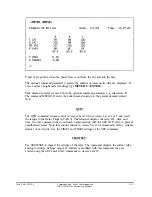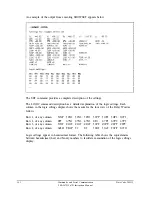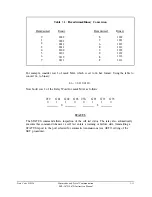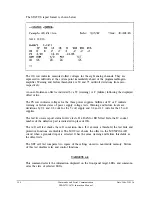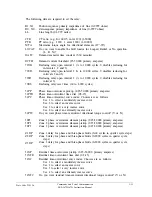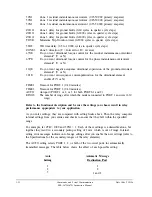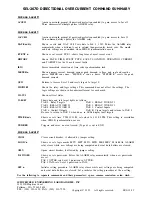
The TYPE column provides an abbreviated indication of event type found in the report. This
is the same data presented as EVENT in the event summary automatically generated for each
fault.
For faults, the indication includes phase-involvement information. The phase-involvement is
determined independently from relay elements. Phase-involvement is determined solely from
uncompensated and load compensated current magnitudes at the midpoint of the first contigu-
ous relay pickup sequence in the event report. See the FAULT LOCATOR section for
algorithmic details.
The phase-involvement is indicated as one of:
AG
: For A-phase to ground faults
BG
: For B-phase to ground faults
CG
: For C-phase to ground faults
AB
: For A-B two-phase faults
BC
: For B-C two-phase faults
CA
: For C-A two-phase faults
ABG : For A-B two-phase to ground faults
BCG : For B-C two-phase to ground faults
CAG : For C-A two-phase to ground faults
ABC : For three-phase faults
For event reports triggered by the assertion of the TRIP output, the TYPE designation is
appended with a
"
T
"
. This aids in determining clearing times for faults which persist beyond
the end of the first event report. For example, if the SEL-267D relay trips for a BG fault
after completing the initial report, the second report shows
"
BGT
"
for TYPE.
For events other than faults, the TYPE indication is either
"
TRIP
"
or
"
EXT
"
. The TYPE
shows
"
TRIP
"
when the SEL-267D relay generates an event report in response to assertion of
the TRIP output, which results from execution of the OPEN command during no-fault
conditions. For all other events, TYPE shows
"
EXT
"
, indicating a report generated in
response to some external stimulus such as the assertion of the ET (External Trigger), PT
(Permissive Trip), BT (Block Trip), or DT (Direct Trip) inputs or by execution of the
TRIGGER command.
The DIST column presents the equivalent distance to a fault in miles. This is calculated using
either the Takagi algorithm or a reactance measurement, depending on whether prefault data
are available in the event report. For some boundary faults of long duration with sporadic
relay operation, the fault-locator may not be able to locate the fault for every report generat-
ed. The DIST column can display
"
999999
"
in such cases (while this behavior can be
contrived under test conditions, it is extremely rare in actual practice).
The column labeled DUR gives a measure of the fault duration. This is calculated using the
first pickup of a Zone 1, 2, 3, 51N, or 51P relay element until the first dropout of all said
relay elements. In other words, it is the duration of the first contiguous pickup of relay
elements found in the long event report converted to units of cycles.
Date Code 920326
Commands and Serial Communication
SEL-267D/167D Instruction Manual
3-9
Summary of Contents for SEL-167D
Page 3: ......
Page 6: ......
Page 8: ......
Page 9: ......
Page 10: ......
Page 11: ......
Page 51: ...LOGIC DIAGRAMS Date Code 920326 Specifications SEL 267D 167D Instruction Manual 2 31 ...
Page 52: ...Date Code 920326 Specifications 2 32 SEL 267D 167D Instruction Manual ...
Page 53: ...Date Code 920326 Specifications SEL 267D 167D Instruction Manual 2 33 ...
Page 54: ...Date Code 920326 Specifications SEL 267D 167D Instruction Manual 2 34 ...
Page 88: ...SAMPLE EVENT REPORT ...
Page 114: ......
Page 115: ......

















